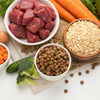What to Feed Dogs to Help Them Gain Weight: A Comprehensive Guide for Pet Owners
- Houndsy
Table of Contents
- Introduction
- Understanding Canine Weight Issues
- Nutritional Needs for Weight Gain
- Human Foods That Help Dogs Gain Weight
- Feeding Strategies for Weight Gain
- Monitoring Progress
- Conclusion
- FAQ
Introduction
Did you know that around 1 in 5 dogs are considered underweight? This can be a serious concern for pet owners who want to ensure their furry friends are healthy and thriving. Whether it's due to a picky appetite, underlying health issues, or even stress, many dogs struggle to maintain a healthy weight. As responsible pet parents, we want to know what to feed dogs to help them gain weight effectively and safely.
In this blog post, we'll delve into the various factors that contribute to a dog's weight loss and explore practical strategies to help our canine companions gain those much-needed extra pounds. We will look at ideal foods, feeding practices, and even some human food options that are safe for dogs. By the end of this article, you’ll have a solid understanding of how to approach your dog’s weight gain journey and the best dietary options available.
Let’s embark on this journey together, considering our pets' unique needs and preferences. As we explore the topic, we encourage you to reflect on your own dog's current feeding habits and whether they could benefit from a weight gain strategy.
Understanding Canine Weight Issues
Why is My Dog Underweight?
Before we can determine what to feed dogs to help them gain weight, it’s crucial to understand the reasons behind their current weight status. Weight loss in dogs can be attributed to several factors, including:
- Health Issues: Illnesses such as diabetes, hyperthyroidism, or gastrointestinal disorders can hinder a dog's ability to gain weight. If your dog has lost weight suddenly or shows signs of lethargy, it’s essential to consult a veterinarian.
- Dietary Insufficiencies: Dogs might not be consuming enough calories or nutrients from their current food. This can be due to low-quality food or inadequate portion sizes.
- Age and Activity Level: Younger dogs, especially puppies, have high energy needs and require more calories than adult dogs. Similarly, highly active breeds burn more calories and may need additional food to maintain their weight.
- Picky Eaters: Some dogs are simply more selective about their food, making it challenging for them to consume enough calories.
Understanding these factors can help us tailor our approach to feeding and ensure we're addressing the root causes of weight loss.
Identifying Your Dog’s Body Condition Score
A useful tool for assessing whether your dog is underweight is the Body Condition Score (BCS) system. This scoring system helps pet owners evaluate their dog's body fat levels and overall health. Typically, the BCS ranges from 1 to 9, where:
- 1/9 = Emaciated: Ribs, spine, and pelvic bones are clearly visible.
- 3/9 = Thin: Ribs are easily felt but not visible.
- 5/9 = Ideal Weight: Ribs can be felt without excess fat covering.
- 7/9 = Overweight: Ribs are difficult to feel under a layer of fat.
- 9/9 = Obese: Excess fat covers the ribs, spine, and pelvic bones.
By regularly assessing your dog's BCS, you can monitor their progress and adjust their feeding strategy as needed.
Nutritional Needs for Weight Gain
The Role of Protein and Fat
When it comes to what to feed dogs to help them gain weight, focusing on high-quality protein and fat is essential. These nutrients are calorie-dense and essential for building muscle mass.
- Protein: Dogs require protein for muscle development and overall health. Look for dog foods that list high-quality sources of protein, such as chicken, beef, or fish, as the primary ingredient.
- Fat: Fat is a concentrated source of energy, providing more calories per gram than protein or carbohydrates. Incorporating healthy fats such as fish oil, chicken fat, or flaxseed oil can help your dog gain weight efficiently.
Choosing the Right Dog Food
There are various types of dog food formulated to support weight gain. Here are some options to consider:
- High-Calorie Dog Food: Look for specialty formulations designed for weight gain. These foods typically contain higher levels of protein and fat than regular dog food.
- Puppy Food: Puppy formulations are often higher in calories because they are designed to support growth and development. Transitioning your adult dog to puppy food can help them gain weight if they are underweight.
- Wet Food: Canned dog food tends to be more palatable and can entice picky eaters. Mixing wet food with dry kibble can also add moisture and flavor, encouraging your dog to eat more.
- Performance Diets: If your dog is particularly active, consider performance diets that provide extra calories and nutrients to support their energy needs.
Human Foods That Help Dogs Gain Weight
In addition to commercial dog food, there are several safe human foods we can incorporate into our dog's diet to help them gain weight. Here are some options:
1. Peanut Butter
A favorite for many dogs, peanut butter is calorie-dense and packed with healthy fats. Just ensure it’s free from xylitol and other additives. You can mix it with their food or use it as a treat.
2. Eggs
Eggs are a fantastic source of protein and healthy fats. Serving cooked eggs (scrambled or boiled) can provide nutritional benefits while appealing to your dog’s taste buds.
3. Cottage Cheese
Full-fat cottage cheese can be an excellent addition to your dog’s diet, providing protein and calcium without causing digestive issues for most dogs.
4. Sweet Potatoes and Pumpkin
These foods are not only nutritious but also help in weight gain. They are high in fiber and can be mixed into your dog's meals for added calories and taste.
5. Lean Meats
Cooked chicken, turkey, or beef can be added to your dog’s regular food. These lean meats provide essential protein and are usually well-received by dogs.
6. Rice
Rice is a good source of carbohydrates and can help bulk up your dog’s diet. Cooked white or brown rice can be mixed with other foods to provide additional calories.
Feeding Strategies for Weight Gain
Meal Frequency and Portion Sizes
- Multiple Small Meals: Instead of two large meals, feeding your dog three to four smaller meals throughout the day can help them consume more calories overall. This approach is easier on their digestive system and encourages better nutrient absorption.
- Increase Portions Gradually: If you notice your dog is not gaining weight, consider gradually increasing their portion sizes. Monitor their weight and adjust as necessary.
Timing of Meals
- Feeding Before Bedtime: Eating a larger meal in the evening can help your dog store calories overnight. This strategy is especially useful for dogs that may burn calories quickly during the day.
- Post-Exercise Meals: Feeding your dog after exercise can aid in recovery and weight gain, as they are likely to be hungrier after physical activity.
Monitoring Progress
As we implement these dietary changes, it’s essential to monitor your dog’s progress closely. Keep a journal to track their weight, feeding habits, and any changes in their behavior or appetite. Regular weigh-ins can help assess whether your strategies are effective.
If after several weeks you don’t see any improvements, or if you have concerns about your dog’s health, it’s crucial to consult a veterinarian. They can help rule out any underlying medical issues and provide tailored recommendations.
Conclusion
Helping our dogs gain weight is about more than just food; it involves understanding their nutritional needs, addressing any underlying health issues, and adopting effective feeding strategies. By focusing on high-quality proteins and fats, incorporating safe human foods, and monitoring our dog’s progress, we can ensure they reach a healthy weight.
As we consider our furry friends' dietary needs, let’s also remember to make mealtimes enjoyable and stress-free. This is where Houndsy's flagship product, the Houndsy Kibble Dispenser, can be especially helpful. Designed for ease of use and aesthetic appeal, it allows for perfect portion control at standing height, minimizing mess and maximizing convenience. Explore the Houndsy Kibble Dispenser today to elevate your dog-feeding experience!
FAQ
1. How can I tell if my dog is underweight?
Check if your dog’s ribs and spine are visible or easily felt without pressure. A severe tuck at the waist or a dull coat can also indicate that your dog may be underweight.
2. What is the best way to transition my dog to a weight gain diet?
Gradually mix the new food with the old food over a week to avoid digestive upset. Start with a small ratio and increase the new food gradually.
3. How long will it take for my dog to gain weight?
Weight gain is a gradual process. You may start to see results within two to four weeks, depending on your dog’s metabolism and the changes made to their diet.
4. Are there any foods I should avoid when trying to help my dog gain weight?
Avoid foods high in fillers and low-quality ingredients, as they may not provide the necessary nutrients for healthy weight gain. Always check with your veterinarian before introducing new foods.
5. Should I exercise my dog while trying to help them gain weight?
Yes! Moderate exercise is important for muscle development and overall health. Just ensure it’s balanced with their calorie intake to promote healthy weight gain.












